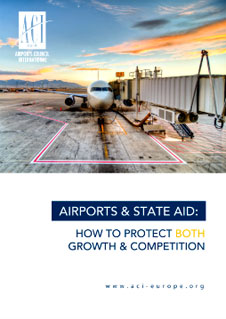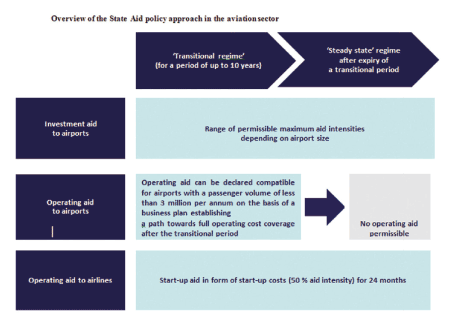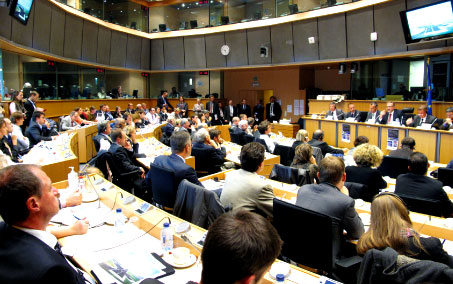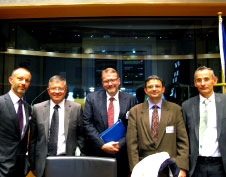
ACI EUROPE has responded to the European Commission’s proposed new guidelines on State aid with its own analysis paper – Airports & State Aid – which calls for specific changes in allowable operating and investment aid, while meeting the twin objectives of economic growth and undistorted competition.
As previously reported in Airport Business, the issue of State aid is a contentious one, particularly in the aviation sector. ACI EUROPE shares with the European Commission the twin objectives of economic growth and undistorted competition, but the new guidelines fail to reflect the harsh economic realities of the smaller airports, and they compromise their significant positive externalities.
Small regional airports are vital public transport infrastructure – in the EU alone, they support a GDP contribution of €16.15 billion and 265,000 jobs. While fostering social and economic development, and local accessibility, figures show that 51% of airports with fewer than five million annual passengers and 65% of those with less than one million are loss-making.
Under the proposals, following a 10-year transitional period, airports with more than 200,000 passengers per year will no longer be able to receive public operating aid. Yet operating aid at smaller airports where annual traffic is below one million passengers, exists precisely because they cannot recover their full costs through airport charges. The increasing market dominance of airlines and the exponential growth of the low-cost carrier (LCC) business model has added competitive pressures to regional airports, which are also at a structural disadvantage in generating the non-aeronautical revenues that are an increasingly important driver of economic sustainability. Donagh Cagney, Manager: Economics, ACI EUROPE, explained: “The guideline proposals on operating aid don’t fit with the financial profiles of small airports. We’re proposing that instead of cutting-off allowed operating aid at the 200,000-passenger threshold, aid should be allowed at decreasing intensities up to one million passengers per year. This would properly reflect the economics of the industry and incentivise growth to financial viability, all while allowing operating aid only where there is genuine need – an important consideration if distortions to competition are to be avoided.”

In the worst case scenario, there is the potential for many airports across Europe to close amongst the 92 with an annual throughput of between 200,000 and one million passengers.
This is very real threat. Piero Righi, Managing Director, S.A.G.A. S.p.A, operator of Pescara’s Aeroporto Internazionale d’Abruzzo, commented that, while the impact of the Guidelines is still being assessed, the closure of the airport, which handled 563,000 passengers in 2012, is a real risk. According to a recent Assaeroporti study, this would cause an increase in the average trip duration of over 30 minutes for 950,000 people, over 60 minutes for 560,000 people, and over 90 minutes for 150,000 people. It would also be devastating to job and growth in the region; Aeroporto Internazionale d’Abruzzo employs 300 staff, and 1,500 jobs in total are supported by the airport’s activities. “The airport contributes over €100 million per year in tourist income to the Abruzzo region, which equals 9% of the total,” explained Righi.

The hearing in the European Parliament brought together more than 100 participants, many of whom were very vocal in their opposition to the new guidelines. In fact, there was strong consensus among the airports, local and regional authorities, and MEPs present, on the need for the guidelines to be amended to support airports’ positive externalities and their essential contribution to growth and jobs.
Investment implications
Another important issue is investment aid for capital expenditure projects. The financing of new infrastructure is challenging for smaller airports, and the guidelines limit aid to airports below five million passengers per year, with less flexibility as airports grow in size.
Righi, commented on this element: “The new Guidelines will certainly limit the possibility to finance investments related to airport and airport-related infrastructures, such as intermodal connectivity.”
Significantly, limited investment aid – 25% intensity – is permitted for airports handling between three and five million passengers, and that must be repaid to public authorities, with interest. Cagney explained that the ACI EUROPE position is that this aid should not be refundable.
The new rules will also effectively close the door on public aid for large-scale infrastructure developments, as no investment aid is allowed for airports with more than 5 million passengers per year. The sheer scale of one-off large airport projects, such as the various proposals for a London ‘gateway airport’, means they cannot always be funded solely by private financing. If Europe’s air transport industry is to remain relevant, there is a requirement to invest to ensure the continued economic and social benefits that airports deliver. EUROCONTROL recently issued another stark warning of the airport capacity crunch. At a time when investment in airport infrastructure should be a priority, the new guidelines fly in the face of this need for more capacity. Provision must be made for investment aid in new greenfield projects, otherwise Europe will be at a major disadvantage compared with emerging economies where investment in aviation infrastructure is a key strategic priority and public aid is commonplace.

Speakers at the EP hearing (L to R): Olivier Jankovec of ACI EUROPE, Frank Proust MEP, Andrew Charlton of Aviation Advocacy, Philippe Alotti of Union des Aeroports Francais and Alain Alexis, DG Competition, European Commission.
ACI EUROPE has engaged constructively with the European Commission on the issue of State aid for more than a year. On 17 September, it also held a joint hearing on the proposed guidelines in the European Parliament in Brussels, in cooperation with Franck Proust MEP (EEP, South West France) and Union des Aéroports Français (UAF). The event brought together more than 100 participants, many of whom were very vocal in their opposition to the new guidelines. In fact, there was strong consensus among the airports, local and regional authorities, and MEPs present, on the need for the guidelines to be amended to support airports’ positive externalities and their essential contribution to growth and jobs.
Franck Proust MEP said: “What is being proposed is too damaging for us to stay quiet, especially when the very future of hundreds of communities and thousands of jobs is at stake. Economic renewal, growth and social cohesion are absolute priorities for Europe right now. Competition policy should be at the service of economic development and growth, not the other way around.”
John Hanlon of the European Low Fare Airline Assocation (ELFAA) was also emphatic and he highlighted how airports and aviation are great drivers of economic growth and employment opportunities. Ian Catlow of Transport for London underlined that more airport capacity will be needed, so why rule out public funding for large airport projects? Without it, he asserted that Istanbul would become the Europe’s primary hub. In his own closing remarks, ACI EUROPE Director General Olivier Jankovec commented “Good policy-making needs to be based on long term vision.”
Crucially, representatives of Member States voiced similar concerns at a meeting organised by the European Commission to get their views on the proposed new Guidelines the day after the joint hearing in the European Parliament.
The public consultation on the new proposals concluded on 25 September. ACI EUROPE has responded with its own analysis paper – Airports & State Aid: how to protect both Growth & Competition – which calls for specific changes in allowable operating and investment aid, while meeting those twin objectives of economic growth and undistorted competition. While the European Commission is the steering wheel here, the voice of Member States will be very influential. Regional airports likely to be affected are therefore encouraged to talk to the regional and national governments of their respective Member States and urge them to make representations to the EC directly. The European Commission is expected to produce final guidelines in January/February 2014.
ACI EUROPE’s Analysis Paper can be downloaded from http://bit.ly/1fuuvIH







